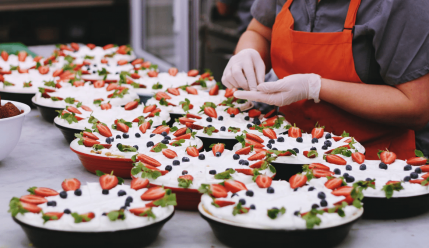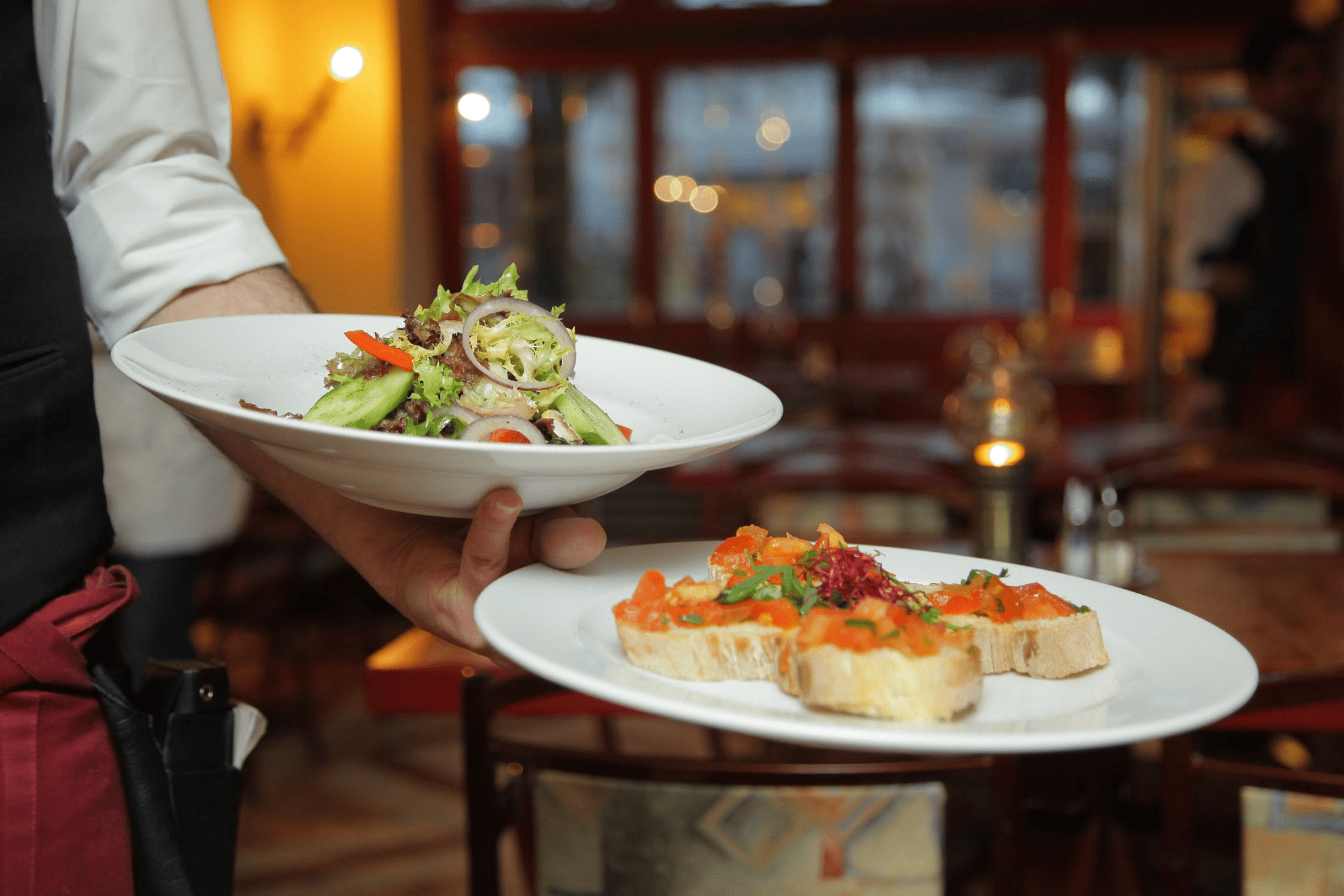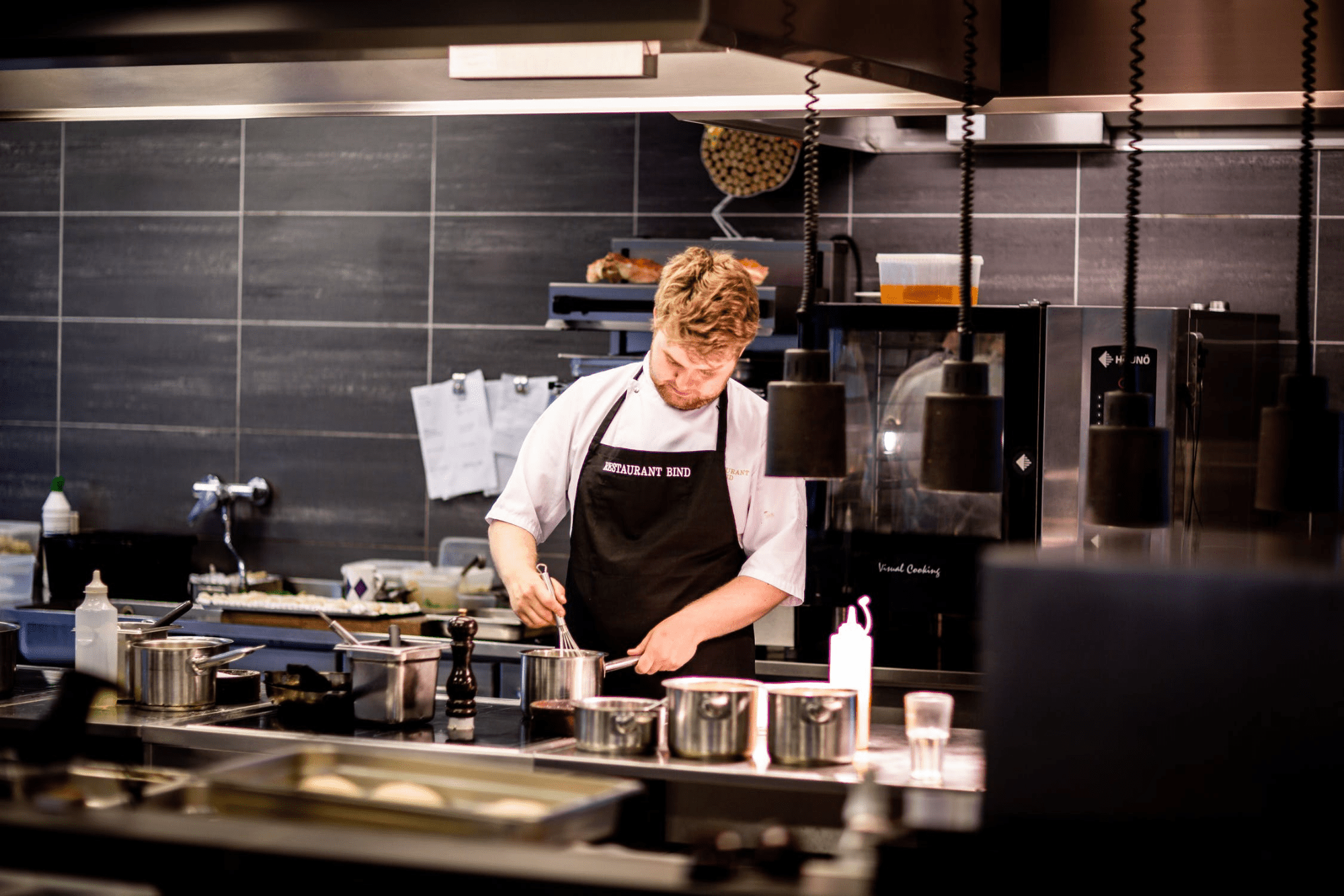Onboarding Checklist: How to Onboard Your Employees the Right Way
Your onboarding checklist should be more than just showing a new employee their ...

For a restaurant to run smoothly and efficiently, you should divide activities into two parts: front of house (FOH)/back of house (BOH).
What’s the difference between FOH and BOH, and how can controlling the two help your business improve? The restaurant-management experts at Sling tell you everything you need to know to maximize productivity and make your restaurant the best it can be.
The difference between FOH (front of house)/BOH (back of house) is one of appearance and presentability.
The “FOH” is any action or area of your restaurant that customers will interact with during their dining experience. For that reason, your FOH should be organized, clean, calm, and as quiet and relaxing as possible for your guests.
We’ll delve deeper into the areas and positions in your restaurant that are FOH in a section below, but it’s important to understand that other aspects of your restaurant also fall into this category.
FOH variables you might not consider include:
Even the diversity of your workforce is an FOH variable.
If you take the time to address all of these issues — not just the cleanliness of your dining room and the appearance of your wait staff — customers will notice and your business will improve.
For more information on perfecting your FOH, take a few minutes to read these helpful articles:

The “BOH” is any action or area of your restaurant that customers will not interact with (or even necessarily see) during their dining experience.
Because your guests will seldom get to peek “behind the curtain,” your BOH can be a bit more active and a bit less orderly than your FOH.
We’re not suggesting that your BOH be chaotic and messy. The team members and areas that are BOH still need to be organized and efficient. But this is the heart of your restaurant and will be in constant motion from the time you open to the time you close.
The energy will be higher and emotions more evident, but that excitement stays confined to the BOH so that the customers can enjoy their meals.
Just like your FOH, the BOH contains key variables that may go unnoticed if you focus exclusively on the physical parts of your restaurant and the employees who work there.
These variables include:
For more tips on how to improve both your BOH and your FOH, check out these informative articles:

As we mentioned earlier, the FOH (front of house)/BOH (back of house) difference lies in where your guests go and whom they see.
Common FOH locations include:
Because of the customer contact in these areas, team members who work there should be clean, well-dressed, and display a professional, accommodating attitude at all times.

The BOH in your restaurant is where your staff prepares food, where they store supplies, and where you conduct administrative tasks behind the scenes so that customers don’t see it.
Common BOH locations include:
Because there is minimal customer contact with the BOH, it can be a little less organized than your FOH, but you still want to keep these areas clean and presentable to maintain productivity levels.

Certain tasks will overlap between FOH (front of house)/BOH (back of house) positions, but, for the most part, BOH staff will remain behind the scenes as much as possible.
Customer-facing FOH positions include:

The BOH is mostly made up of food-prep staff and those who assist them.
BOH positions include:

The success of your restaurant isn’t about one side or the other. As the subheading expresses, success equals front of house and back of house working together to provide the best customer experience possible.
It’s vital that you — the manager — and the ownership of the restaurant take this fact to heart and do everything within your power to bring the FOH and the BOH together as one unit, not two separate teams that have to work together occasionally.
It’s also important to instill this fact — you’re one team, not two — in all your employees.
Everyone from the head chef and the dining room manager, right down to the dishwasher and the busser, should understand that they’re an integral part of making your restaurant run smoothly.
That may take some effort on your part, as many managers tend to put more focus on the FOH because it’s the public face of the business.
But think of your restaurant as a beautifully decorated cake. Yes, the outside (the FOH) looks wonderful, but when you bite into it, the cake itself (the BOH) is raw and inedible.
A well-baked pastry (or a well-run restaurant) is all about both sides (appearance and flavor) working together to make something great.
It’s management’s responsibility to bring the FOH and the BOH together to work as one.

Whether you choose to institute tip sharing or tip-pooling — there is a difference — you can foster a sense of camaraderie between the front-of-house staff and the back-of-house staff by distributing the gratuity to all.
This gives everyone involved in the customer experience the motivation and the drive to provide the best food and service possible.
Creating an equitable tip sharing (or pooling) process takes time and effort, but the benefits to morale and employee engagement are well worth the work.
The goals of successful team communication differ from business to business, but a handful of fundamental elements influence the FOH/BOH relationship regardless of size, industry, or niche.
These basic elements include:
As restaurant manager, it’s your job to put these basic elements front and center in everything you and your team do.
When your restaurant culture includes high levels of these seven elements, communication becomes much easier and the members of your FOH and BOH will be more willing to engage in this essential activity.
Check out these articles from Sling to help you enhance communication throughout your business:
The simple act of eating a meal together can have profound effects on the relationship between your front-of-house employees and your back-of-house employees.
Consider gathering together once a week for a group meal. You could have food brought in, make it yourself, or have everyone contribute a dish.
You also might consider combining this meal with a weekly team meeting. But don’t jump right into business and neglect the pleasure. Dedicate the bulk of the time to socializing and enjoying the food and companionship.
Keep an eye on what everyone’s doing. When the food is finished and the conversation starts to flag, take 10 or 15 minutes to address a few work-related issues.
Rather than just stressing the standard operating procedure of your restaurant during a new employee’s first few days, take the time to focus on team unity and how both the FOH and BOH work together to make your business great.
This will pay dividends down the road in the form of better morale, better team communication, a happier work environment, better business practices, and, ultimately, more satisfied customers.
For suggestions on perfecting your onboarding process to improve front-of-house/back-of-house relationships, take a moment to read these helpful resources:

Another great way to build teamwork between the FOH and the BOH is to have new employees switch jobs for a shift.
For example, if you hire a new server, make it part of their on-the-job training to work in the kitchen chopping vegetables, washing dishes, or helping out in other ways once or twice a week during slow shifts.
Similarly, if you hire a new line chef, have them shadow an experienced server or work as a food runner during the onboarding process.
Providing FOH employees with exposure to the demands and responsibilities of the back of the house (and vice versa) helps everyone develop respect and appreciation for what the other members of the team are going through when things get busy.
This forges a “we’re all in this together” attitude that is invaluable for improving FOH/BOH relations.
You can increase the teamwork between your front of house and back of house by making an effort to resolve conflicts and arguments between team members as soon as possible after they happen.
While it’s true that some constructive conflict (or friendly disagreements) can build the team up, real discord can tear the team down until no teamwork is possible.
When negative conflict does occur, give your team members the chance to resolve it on their own. If they can’t reach an accord, take the opportunity to step in, mediate, and facilitate a solution.
Similarly, don’t let difficult employees spoil the relationship between your FOH and BOH staff. If a team member is infecting the unity of your team, take the necessary steps to prevent their behavior from spreading to other employees.
The interface between the FOH and the BOH (the food window) is a chaotic place.
Servers come here with requests or order changes. Cooks ask questions about an order or pass on information about your restaurant’s fare through the food window. During busy shifts, emotions run high and problems arise where the FOH and the BOH meet.
To prevent conflict at the food window, employ an expeditor. The expeditor acts as a liaison or an intermediary between the kitchen and the dining room and makes sure that the food window runs as smoothly as possible.
Their job is to ensure that everything passing through the food window is up to your restaurant’s high standards. They’re also there as a conduit of communication between servers and chefs.
Designating one or two people as expeditors prevents disagreements when emotions run high and ensures that all requests, questions, and problems are heard, understood, and remedied as quickly as possible.
Whether it’s the end of a busy service or an individual job well-done, it’s key to the FOH/BOH relationship that you celebrate those successes.
It’s also essential that you’re not the only one to offer kudos and appreciation; encourage your team to celebrate without you as well.
By all means, arrange for a bit of recognition for all involved, but then let them go out for a bit of post-work celebration on their own. Doing so builds camaraderie, acts as an incentive for the next busy shift, and reinforces the team bonds you’ve worked so hard to build.

The best way to ensure that your FOH (front of house) and BOH (back of house) work well together is to schedule team members with productivity and efficiency in mind.
The Sling suite of scheduling and workforce management tools makes this possible, easy, and enjoyable.
The heart of the Sling software is its artificial-intelligence-based scheduling module that includes intuitive features like:
Sling also contains a built-in time clock and employee work and attendance tracker. With this unique feature, you can turn any smartphone, tablet, or computer into a clock-in, clock-out tool.
You can even control FOH/BOH labor costs and prevent time theft by establishing geofences around your business and setting limits on how early and how late employees can clock in or out.

But the benefits don’t stop there. With Sling, you also get:
When you harness the power of the Sling app, coordinating FOH/BOH activities takes little time at all and gives you the opportunity to focus on growing your restaurant and ensuring its success.
For more free resources to help you manage your business better, organize and schedule your team, and track and calculate labor costs, visit GetSling.com today.
See Here For Last Updated Dates: Link
This content is for informational purposes and is not intended as legal, tax, HR, or any other professional advice. Please contact an attorney or other professional for specific advice.
Schedule faster, communicate better, get things done.